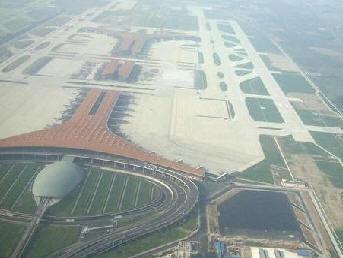
NEWSROOM
 |
NEWSROOM |
|
|
|
|
|||
|
By Mike Mitchell |
||||
 |
November 30, 2009 - The third runway at Beijing Capital International
Airport (BCIA) became operational on 29 October, easing the traffic
pressure at the country's busiest airport. "The airport handles 1,100
arrival and departure flights every day. That will probably rise to
1,500 to 1,600 and peak at 1,900 during the Olympics next year, so the
third runway is much needed, " said a BCIA spokesperson.
This new runway, which is equipped with an advanced landing guidance
system and is 3,800 meters in length and 60 meters in width, passed the
appraisal by the General Administration of Civil Aviation of China
(CAAC) on October 20 and went into use as scheduled.
"The new runway is able to accommodate the largest airliner in the
world, the Airbus A380," said airport general manager. It is part of an
expansion project that includes a new terminal building, 100 new aprons,
a cargo zone and auxiliary facilities. |
|||
|
The project will
enable the airport to accommodate 60 million passengers and handle 1.8
million tons of cargo each year. The new terminal building is expected
to come into use in February 2008. Meanwhile, the civil aviation
authority has submitted a proposal for the site of the planned second
"The preliminary site is to the south of the city and near the
" |
||||
|
Location surveys for the new airport site were conducted in 2002 and 2003, but the scheme was suspended when it was decided to expand the BCIA first. "When the location plan was approved by the central government, the CAAC will conduct a feasibility research," said the official from the CAAC. Experts believe a second airport will greatly boost the economic development of the whole Beijing-Tianjin-Hebei area.
The
Beijing Capital has rapidly ascended in rankings of the world's busiest
airports in the past decade. In 2001, the airport served 24.18 million
passengers and was ranked outside of the Top 30 in the world by
passenger volume. By 2008, passenger volume had more than doubled to
55.94 million, making Beijing Capital the 8th busiest airport in the
world. In 2008, the airport registered 431,670 aircraft movements
(take-offs and landings), which ranked 21st in the world, making Beijing
Capital the only Asian airport in the Top 30. In terms of cargo traffic,
In 2009, for its annual World's Best Airport Award, Cond? Nast Traveler
magazine awarded World's
To accommodate the growing traffic volume, Beijing Capital added the
enormous Terminal 3 in 2008, the second largest airport terminal in the
world after |
| ?AvStop Online Magazine Contact Us Return To News |